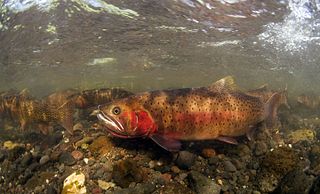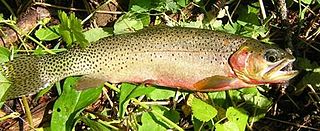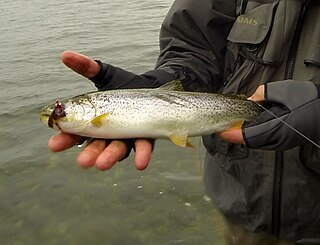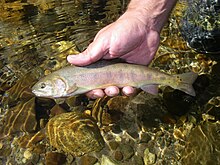Natural history
Though the Lahontan cutthroats and the Paiute cutthroats, are very similar subspecies, they are genetic distinctions between the two, as is seen through their spots on their body or lack thereof for the Paiute cutthroats. It is believed that the Paiute cutthroats separated from the Lahontan cutthroats around 5–8,000 years ago from the East Fork Carson River population, which became isolated in Silver King Creek above Silver King Canyon Gorge after erosion made the gorge impassable to trout swimming upstream. [8]
The upstream population then adapted to local conditions independent of the larger population below that had evolved in pluvial Lake Lahontan during the Pleistocene. Although Lahontan cutthroats are heavily spotted, the isolated sub-population lost virtually all spotting, perhaps because spots made fish more visible and susceptible to predation in the ultra-clear and shallow mountain stream. Paiute cutthroats are also notable for a purple coloration, whereas Lahontan cutthroats have bronze coloration. The Paiute strain must have adapted to a diet mainly of insects and become less migratory since juvenile fish swimming downstream in search of larger waters would have passed below downstream barriers and left the isolated gene pool.
Habitat
Similar to other salmonids, Paiute cutthroats require clear, cold, and oxygenated waters and stream pools with an abundance of vegetation for reproduction purposes and for refuge from the winter. [7]
Historically, Paiute cutthroats occupied only 17.8 km of stream space in the Silver King Creek drainage from the Llewellyn Falls to the Silver King Canyon. During this time, they were also found in three tributaries: Tamarack Creek, Tamarack Lake Creek, and the lower parts of Coyote Valley Creek. [7]
Now, Paiute cutthroats occupy 37.8 km of stream space in five different drainages. The Silver King Creek Drainage is found in the Carson-Iceberg Wilderness where the Paiute cutthroats occupy 11.9 km of stream space, including the middle portion of the Silver King Creek which is its natural historical range. Nonnative rainbow trout occupied this space until they were removed between 2013 and 2015 with piscicide. On September 18, 2019, 30 Paiute cutthroats were translocated there from Coyote Creek, marking the first time since the 1900s that they were in their historical range. [9] [7]
Aside from the Silver King Creek Drainage, Paiute cutthroats are found in the White Mountains Wilderness (North Fork Cottonwood Creek, Cabin Creek, and Leidy Creek), the Ansel Adams Wilderness (Stairway Creek), and the John Muir Wilderness (Sharktooth Creek). [7]
Conservation
Basque sheepherders began grazing sheep along upper Silver King Creek in the 1800s. They noticed the unusual trout and by 1912 had transplanted them above Llewellyn Falls which had originally been the upper limit. This is fortunate because by 1924 hybrids with ordinary Lahontan cutthroat and introduced rainbow trout (cutbows) were found below Llewellyn Falls, either due to ill-considered stocking or barriers in the gorge washing out.
Since the finite and localized population of Paiute cutthroats was vulnerable to forest fire and angling as well as hybridization, relatively unhybridized Paiute cutthroats from upstream were transplanted into virtually all available tributaries of Silver King Creek above the gorge, into Stairway and Sharktooth Creeks to the south in the Sierra Nevada, and into Cottonwood Creek and Cabin Creek in the White Mountains.
The subspecies was listed as an endangered species in 1967. [3] In 1975, its status was upgraded to threatened, a status which it still maintains since the 2020 5-Year Status review. [10] [7]
Subsequent studies have found some degree of hybridization in virtually all populations of Paiute cutthroats, especially between 1930 and 1994 with non-native fish like the California golden trout (Oncorhynchus mykiss aguabonita) and rainbow trout (Oncorhynchus clarkii ssp.). In the early 1990s, the California Department of Fish and Game reduced hybridization by chemically treating stream segments with higher levels of introgression and transplanting Paiute cutthroats from other stream segments thought to be less hybridized. These populations would then be isolated and monitored by the California Department of Fish and Game. [9]
Angling is prohibited in most streams where Paiute cutthroats predominate, however future plans include downstream expansion of Paiute cutthroat range by removing other trout and installing barriers. [11]
Although restoration plans were delayed by lawsuits concerned about the impact of rotenone on other stream inhabitants, the U.S. Fish & Wildlife Service decided in May, 2010 to proceed with poisoning to eradicate non-native and hybrid trout in Silver King Creek from Llewellyn Falls downstream to the confluence with Snodgrass Creek and associated tributaries; and to restore Paiute cutthroat trout to its historical range through stocking. [6] [12] When populations are sufficient, the subspecies may be de-listed and limited angling may be permitted.

Trout is a generic common name for numerous species of carnivorous freshwater ray-finned fishes belonging to the genera Oncorhynchus, Salmo and Salvelinus, all of which are members of the subfamily Salmoninae in the family Salmonidae. The word trout is also used for some similar-shaped but non-salmonid fish, such as the spotted seatrout/speckled trout.

The Truckee River is a river in the U.S. states of California and Nevada. The river flows northeasterly and is 121 miles (195 km) long. The Truckee is the sole outlet of Lake Tahoe and drains part of the high Sierra Nevada, emptying into Pyramid Lake in the Great Basin. Its waters are an important source of irrigation along its valley and adjacent valleys.

The Carson River is a northwestern Nevada river that empties into the Carson Sink, an endorheic basin. The main stem of the river is 131 miles (211 km) long although the addition of the East Fork makes the total length 205 miles (330 km), traversing five counties: Alpine County in California and Douglas, Storey, Lyon, and Churchill Counties in Nevada, as well as the Consolidated Municipality of Carson City, Nevada. The river is named for Kit Carson, who guided John C. Frémont's expedition westward up the Carson Valley and across Carson Pass in winter, 1844. The river made the National Priorities List (NPL) on October 30, 1990 as the Carson River Mercury Superfund site (CRMS) due to investigations that showed trace amounts of mercury in the wildlife and watershed sediments.

The cutthroat trout(Oncorhynchus clarkii) is a fish species of the family Salmonidae native to cold-water tributaries of the Pacific Ocean, Rocky Mountains, and Great Basin in North America. As a member of the genus Oncorhynchus, it is one of the Pacific trout, a group that includes the widely distributed rainbow trout. Cutthroat trout are popular gamefish, especially among anglers who enjoy fly fishing. The common name "cutthroat" refers to the distinctive red coloration on the underside of the lower jaw. The specific name clarkii was given to honor explorer William Clark, coleader of the Lewis and Clark Expedition.

The Bonneville cutthroat trout is a subspecies of cutthroat trout native to tributaries of the Great Salt Lake and Sevier Lake. Most of the fish's current and historic range is in Utah, but they are also found in Idaho, Wyoming, and Nevada. This is one of 14 or so recognized subspecies of cutthroat trout native to the western United States.
![<span class="mw-page-title-main">Little Truckee River</span> River in [[Nevada County, California]] and [[Sierra County, California]], United States of America](https://upload.wikimedia.org/wikipedia/commons/thumb/8/81/Upper_little_truckee_river.jpg/320px-Upper_little_truckee_river.jpg)
The Little Truckee River is a 34.3-mile-long (55.2 km) river that is a tributary to its larger counterpart, the Truckee River, north of Lake Tahoe. It drains the eastern flank of the Sierra Nevada, flowing through Sierra County and Nevada County in eastern California.
The Alvord cutthroat trout, Oncorhynchus clarkii alvordensis, was a subspecies of cutthroat trout. It was known only from Trout Creek in Oregon and Virgin Creek in Nevada, although it may have lived in several of the larger Alvord Basin streams during recent times. It was native to spring-fed creeks that ran down to Alvord Dry Lake in southeast Oregon, which was a large lake during the ice ages and an isolated drainage, part of the Great Basin today. This is one of the two cutthroat trout taxa considered extinct because all known populations are hybridized with rainbow trout which were introduced into streams in the Alvord basin in the 1920s, resulting in cutbows.

Lahontan cutthroat trout is the largest subspecies of cutthroat trout, and the state fish of Nevada. It is one of three subspecies of cutthroat trout that are listed as federally threatened.

The Yellowstone cutthroat trout is a subspecies of the cutthroat trout. It is a freshwater fish in the salmon family. Native only to a few U.S. states, their original range was upstream of Shoshone Falls on the Snake River and tributaries in Wyoming, also across the Continental Divide in Yellowstone Lake and in the Yellowstone River as well as its tributaries downstream to the Tongue River in Montana. The species is also found in Idaho, Utah and Nevada.

The Colorado River cutthroat trout is a subspecies of cutthroat trout native only to the Green and Colorado River basins, which are west of the Continental Divide. Cutthroat trout found in other river basins belong to other subspecies.

The greenback cutthroat trout is the easternmost subspecies of cutthroat trout. The greenback cutthroat, once widespread in the Arkansas and South Platte River drainages of Eastern Colorado and Southeast Wyoming, today occupies less than 1% of its historical range. It is currently listed as threatened under the Endangered Species Act. It was adopted as the state fish of Colorado on March 15, 1994, replacing the unofficial rainbow trout.

The westslope cutthroat trout, also known as the black-spotted trout, common cutthroat trout and red-throated trout is a subspecies of the cutthroat trout and is a freshwater fish in the salmon family of order Salmoniformes. The cutthroat is the Montana state fish. This subspecies is a species of concern in its Montana and British Columbia ranges and is considered threatened in its native range in Alberta.

The coastal cutthroat trout, also known as the sea-run cutthroat trout, blue-back trout or harvest trout, is one of the several subspecies of cutthroat trout found in Western North America. The coastal cutthroat trout occurs in four distinct forms. A semi-anadromous or sea-run form is the most well known. Freshwater forms occur in both large and small rivers and streams and lake environments. The native range of the coastal cutthroat trout extends south from the southern coastline of the Kenai Peninsula in Alaska to the Eel River in Northern California. Coastal cutthroat trout are resident in tributary streams and rivers of the Pacific basin and are rarely found more than 100 miles (160 km) from the ocean.

The Crescenti cutthroat trout or the Lake Crescent cutthroat trout is a North American freshwater fish, a local form of the coastal cutthroat trout isolated in Lake Crescent in Washington. While previously attributed to a distinct subspecies Oncorhynchus clarkii crescenti, it is not currently recognized at the subspecies rank. However the cutthroat trout of Lake Crescent do remain distinct. They have the highest known gill raker and vertebrae counts of any coastal cutthroat population. The cutthroat are believed to have been isolated in Lake Crescent after a landslide blocked the eastern outflow of the lake.

The Carson–Iceberg Wilderness is a federal wilderness area located 80 miles (130 km) northeast of Stockton, California. It encompasses 160,000 acres (650 km2) and was designated by the California Wilderness Act of 1984. It protects an area of High Sierra landscape with elevations from 4,800 feet (1,500 m) to 11,462 feet (3,494 m) along the Sierra Mountains from Ebbetts Pass to Sonora Pass in the south. The US Forest Service manages the wilderness which is in both the Stanislaus National Forest and the Humboldt–Toiyabe National Forest.
The Humboldt cutthroat trout is a subspecies of cutthroat trout, a North American fish in the family Salmonidae. It is one of the several subspecies of cutthroat trout. It was formally scientifically named in 2008 by Trotter and Behnke, who stated its distribution is in the basins of the upper Humboldt River of northern Nevada, the Upper Quinn River, as well as the Whitehorse (Coyote) basin (Oregon). The Nevada and Oregon Fish and Wildlife authorities still consider these populations belonging to the subspecies O. c. henshawi.
The Willow-Whitehorse Basin cutthroat trout refers to a population segment of the cutthroat trout complex from the streams of the Whitehorse Basin, southeastern Oregon. It is alternatively considered as a part of the Lahontan cutthroat trout subspecies, or of the Humboldt cutthroat trout whose main range is in Nevada. These fish have adapted to live under extreme conditions, and can withstand water temperatures as high as 85 °F for short periods of time.

The Kern River rainbow trout is a localized subspecies of the rainbow trout, a variety of fish in the family Salmonidae. It is found in a short section of the main stem of the Kern River and several tributaries in the southern Sierra Nevada in California. The Kern River rainbow trout is a "Species of Special Concern" in the state of California due to habitat loss and hybridization with other native and non-native trout in their range.

Cascade Lake is a glacial lake located in El Dorado County, California approximately 1 kilometre (0.62 mi) from Lake Tahoe. Cascade Lake is the second largest tributary lake feeding into Lake Tahoe. Its depth is 170 feet (52 m), 1 mile (1.6 km) long and 0.5 miles (0.80 km) wide. The lake is also within three to four miles from its neighboring lake, Fallen Leaf Lake, and Emerald Bay.









![<span class="mw-page-title-main">Little Truckee River</span> River in [[Nevada County, California]] and [[Sierra County, California]], United States of America](https://upload.wikimedia.org/wikipedia/commons/thumb/8/81/Upper_little_truckee_river.jpg/320px-Upper_little_truckee_river.jpg)









